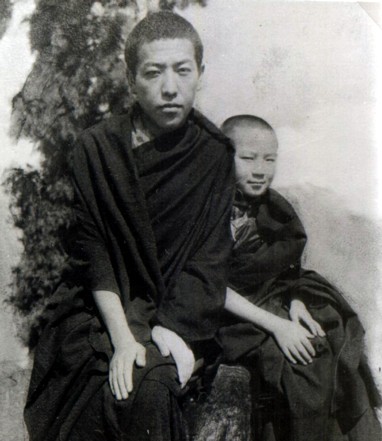Thartse Khen Rinpoche

Ngor Thartse Khenpo Sonam Gyatso Rinpoche aka Hiroshi Sonami (1930-1988)[1] — a disciple of Jamyang Khyentse Chökyi Lodrö. Khen Rinpoche was born into a noble family in Lhasa. His father, Tsipon Shuguba, was one of the Treasurers of the central government of Tibet under HH the Dalai Lama, the father of four tulkus, and was appointed by the Dalai Lama to lead the final defense of Lhasa as His Holiness escaped. Tsipon Shugba, after 19 years of imprisonment, was brought to America by his sons in 1980. During the Tsipon's imprisonment he also endured the death of his daughter and also that of his beloved wife, who departed this life by means of Phowa on the eve of her 'show trial' by the Communist authorities. Tsipon Shugba wrote his memoirs, an invaluable record of life before the fall of Old Tibet and existence under the Chinese regime, In the Presence of My Enemies: Memoirs of a Tibetan Nobleman[2].
Sonam Gyatso was recognized by the 39th Kyabgön Sayka Trizin Dragshul Thinley Rinchen and ratified by HH the XIII Dalai Lama Thubten Gyatso as the incarnation of the previous Khenpo of the Thartse Monastery at Ngor, and so he was subsequently enthroned as well as Khenpo of Ngor Thartse Monastery and trained accordingly. One of Khen Rinpoche's brothers, who was recognized as a Gelugpa tulku, today lives in Switzerland. His younger brother, Lama Kunga Rinpoche, who is founder and resident lama of Ewam Choden (Sakyapa) Tibetan Buddhist Center in Berkeley, California, was born in 1935 and recognized as the tulku of Sevan Repa, one of the heart-sons of Milarepa, and initially lived in a Kagyu monastery but found Ngor Thartse Monastery more congenial and became a Sakyapa lama and was made Thartse Shabdrung. Khen Rinpoche escaped from Tibet in 1958, managing to bring Ngor Monastery's famed collection of mandala thangkas, thereby saving them for posterity. His brothers Thartse Shabdrung Rinpoche and Tsensab Rinpoche escaped the next year.
After his escape, Khen Rinpoche worked in the Tibetan section of the National Library of Japan (hence the alternate name of Hiroshi Sonami, a Japanese rendering of Sonam Gyatso) and authored Tibetan Mandalas: The Ngor Collection. This complete and accurate catalogue raisonne of the famed Ngor monastery collection of 139 painted mandalas, which is a visual record of the Compendium of Knowledge (Wylie: rGyud sde kun btus) of Jamyang Loter Wangpo (1847-1914), a treasury of esoteric tantric knowledge which derives from the flowering of the Rime movement in the 19th and 20th centuries.
Khen Rinpoche's analytical text represents the authoritative and complete analysis of the Compendium of Tantras as well as an explanation of the system of the rGyud sde kun btus. Appended as well is a complete list of the meditational deities of each thangka as well as with their Sanskrit root texts and rGyud sde kun btus text for each respective teaching. As a result of the extensive vandalism of the so-called 'Cultural Revolution' carried out by the Chinese in Tibet, the collection of mandalas rescued by Khen Rinpoche is the only surviving complete set of the mandalas of one of the four principal schools of Tibetan Buddhism in existence, and represents an irreplaceably precious contribution to the religious history of humanity. Only 300 copies of Khen Rinpoche's book on the Ngor Mandala Collection exist, and when one came to market in 2008 its price was in the region of $8000US.
Khen Rinpoche subsequently relocated to Berkeley, California, where he lived until he departed this realm due to stomach cancer. A deeply humble and compassionate man, he lived quietly, engaged in his studies and meditation. At the time of his death, Khen Rinpoche was translating an important Tibetan Abhidharma text, Three Experiences: The Jewel That Pleases, an esoteric text detailing psychology and metaphysics on the path and attainment of Buddhahood.
Khen Rinpoche sometimes casually remarked that there must have been a mistake when he was enthroned as one of the highest ranking tulkus in the Sakya School. However, this observation was seen by his devoted friends and followers as yet one more example of his profound realization by putting himself below others since he was, in fact, a remarkable lama and the farsighted and courageous savior of a unique facet of the Triple Gem.
Publications
- Ngor Thartse Khenpo Sonam Gyatso (bSod nams rgya Mtsho), Tibetan Mandalas: The Ngor Collection, Tokyo, Kodansha, 1983
Notes
- ↑ Dhongthog Rinpoche's autobiography gives his dates as 1933-1987.
- ↑ Clearlight Publishers, 1995.